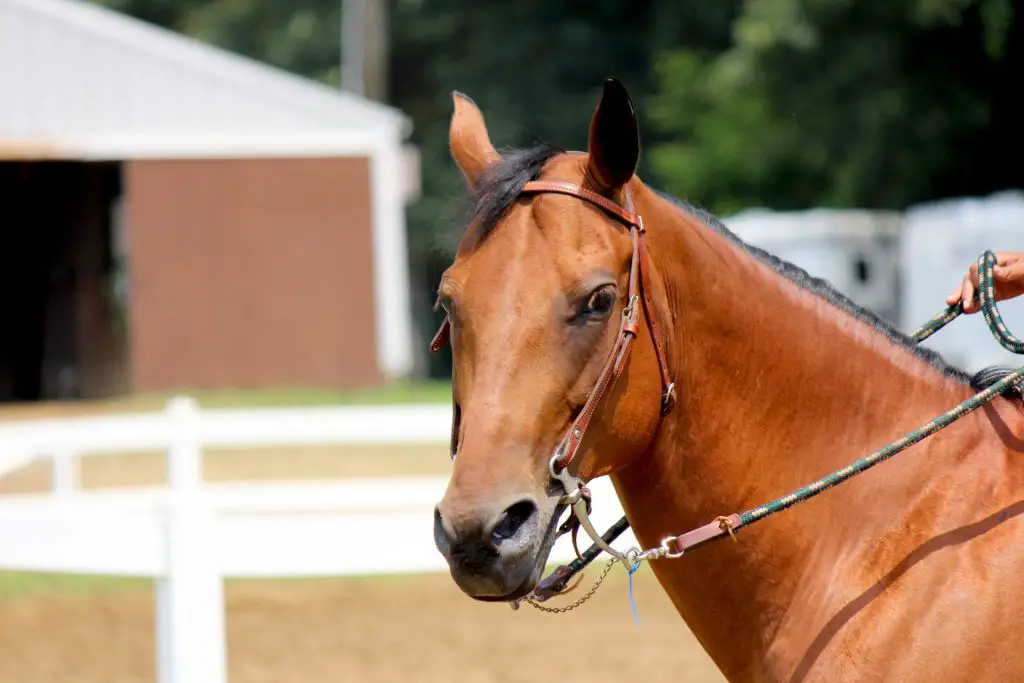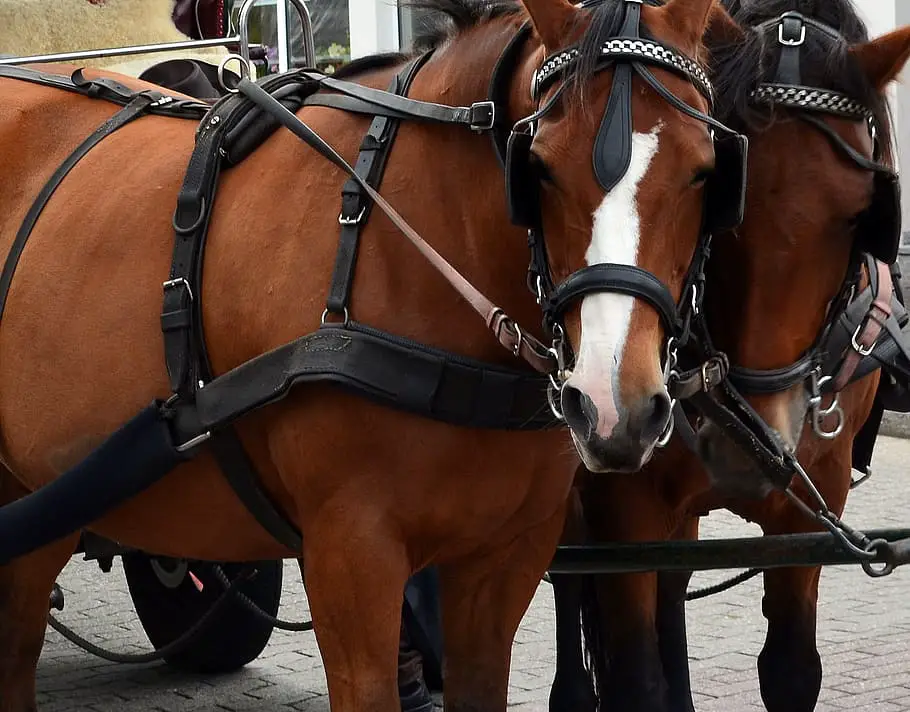Last Updated on August 8, 2020 by Allison Price
What is Bridle? A horse bridle is an important piece of equipment used in horse riding. It is usually used by riders to communicate with their horse while riding. It is a headgear by which a horse or other burden-bearing or pulling animal is usually governed. Using bridle provides better communication, promotes a true partnership between horse and rider. It does not interfere with either breathing or striding. As a result, performance is actually improved. Horse bridles are sometimes confused with halters. A bridle is generally used by a person who is riding or driving an animal that has been then trained. On the other hand, a halter is usually used by horse handlers on the ground to lead or tie up an animal.
Purpose of Bridles
Horses are usually trained to respond to a rider thus, using a bridle makes this a lot easier. It also improves a horse’s balance. It lightens the forehand, lengthens the stride, strengthens impulsion, and increases speed. Improvements in horse’s performances can be usually anticipated in all types of activity.
Different Types of Bridles

Snaffle Bridle
Snaffle Briddle is the most commonly used bridle in English riding, with one bit and a set of reins. It can be usually used with most types of single rein bits. This includes single curb bits, gag bits, and Kimberwicks.
Fox hunting Bridle
Fox hunting Bridle works with a single Pelham bit. It uses two sets of reins; one for snaffle action and one for curb action.
Figure 8 Bridle
Figure 8 Bridle gets its name from the crossed noseband that resembles the number eight. This bridle is usually used on jumpers and event horses.
Double Bridle
Double Bridle is sometimes called Weymouth bridle. It uses two bits at once: a small snaffle bit, also called a bradoon, and a curb bit or Weymouth bit.
Hackamore Bridle
A hackamore bridle does not use a bit. Instead, the shanks on the mechanical hackamore serve as a bit. The hackamore places pressure over the nose and other points of the horse’shead.
Barcoo Bridle
Barcoo Bridle is an Australian stock horse bridle that doesn’t even have a noseband. It is usually used both at work and in competition. The crownpiece, browband and throat latch are all sewn together. It is usually sewn either side of the head onto a ring between the horse’s ears. The cheek strap is a single strap that attaches to a buckle on the outside of the ear, through the bit and the collar.
Gag Bridle
Gag Bridle has rounded cheek pieces passing through the top and bottom holes in a gag’s bit ring. It is then attached directly to the reins. Tension on the reins rotates the bit, slipping it up into the cheek pieces and the corners of the lips.
How Does Bridle Work?
The bit, headpiece, and reins all work together to communicate with the horse. Bits work by applying pressure inside the horse’s mouth. Depending on the bit used, it may apply pressure on the horse’s tongue, the roof of the mouth, and the corners of the mouth. The primary use for the headpiece is to hold the bit in place in a horse’s mouth. It also may create extra pressure on a horse’s cheeks, chin, nose, or poll. The bit rests on the gums in a space between the incisors and molars. This needs to be in its proper place to work and to be comfortable for the horse.
The Bitted and Bitless Bridle
The Bitted Bridle is usually used on exerting pressure on the sensitive mouth. The Traditional Bitless Bridles work by applying nose pressure. (i.e.,the Hackamores, bosals, and sidepull). Some bridle allows the rider to communicate through painless pressure. It is usually distributed around the whole of the head. It distributes gentle pressure too far less sensitive tissues. It also distributes an even amount of pressure over a wide area. It is usually done by two loops, one over the poll and the other over the nose.
Do Bridles Hurt Horses?
The answer depends on the type of Bridle used. Using a bridle that applies pressure on either the mouth or nose is painful. Other Bitless Bridle in the market, nowadays, is less painful. You need to be sure the pressure from the bridle is actually distributed on parts of the head to even out pressure.
Different Parts of the Bridle

There are three primary horse bridle parts. These are the Headpiece, Bit, and Reins.
The Headpiece
This is the part that fits around the horse’s head. It consists of leather pieces that can be usually adjusted to fit the horse. It shouldn’t be too tight or it will cause discomfort. And a bridle that is too loose can come off or can rub the horse and create sore spots. A comfortable, secure fit is essential.
The headpiece includes the following:
- Crown Piece — is the main strap that goes over a horse’s head, behind the ears. It holds the rest of the bridle in place.
- Cheek Pieces — are straps that connect the bit to the crown piece. It can be usually adjusted to fit the horse for comfort and to maximize responsiveness.
English bridles have two cheek pieces. It attaches to either end of the crown piece and runs down the side of the horse’s cheekbones and to the bit rings. You can also buy a bradoon hanger for horses moving into a double bridle. A double bridle is a single strap with a left-side adjustable buckle and attachments for the bit at each end. It is usually worn under a snaffle bridle to create a double bridle effect.
Throatlatch
Throatlatch is generally part of the crown piece leather. The throatlatch runs from the horse’s right ear under the throat. It then attaches below the left ear on the left side of the jaw. It prevents the bridle from slipping over the horse’s head.
Browband
Browband connects the crownpiece across the front of a horse’s forehead. This holds the bridle pieces together. It also prevents the bridle from sliding behind the poll onto the upper neck.
Noseband
The noseband helps to hold the bit in place and can be usually used to keep the horse’s mouth closed. You will sometimes see a Caveson noseband on English bridles. This is usually attached to its own headstall. Also, it is then connected to the bridle by the browband. These are usually known as mono crown bridles. They are useful for adjusting with greater precision.
The Bit
A bridle bit goes into the horse’s mouth and is usually used with the reins to communicate with the horse. Snaffle bits are mostly used for English riding, and they come in many variations.
The Reins
The reins consist of a long, narrow strap that attaches to the bit. Reins are then held in a rider’s hands and are usually used to guide the horse while riding.
Dangers of Tying your Horses Using Bridles
It is not safe to tie a horse using a bridle for two contradictory reasons. First, if the tied animal pulls back on the bridle, the bit or controlling noseband may cause severe pain. It can even damage the animal’s jaw, tongue, or other facial structures even if the bridle breaks. Second, most bridles are usually made of thin leather compared to halters. They will crack easily under pressure. The end result can be both horse injury and equipment breakage. It is best to avoid doing tying your horses using bridles at all costs.


